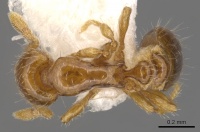Strumigenys paradoxa
| Strumigenys paradoxa | |
|---|---|

| |
| Scientific classification | |
| Kingdom: | Animalia |
| Phylum: | Arthropoda |
| Class: | Insecta |
| Order: | Hymenoptera |
| Family: | Formicidae |
| Subfamily: | Myrmicinae |
| Tribe: | Attini |
| Genus: | Strumigenys |
| Species: | S. paradoxa |
| Binomial name | |
| Strumigenys paradoxa (Bolton, 2000) | |
The single type specimen was collected at La Selva Biological Station. It was from a 10cm deep soil/litter core placed in a Berlese funnel. The soil core came from trap site 3 of the ALAS project, La Selva GIS 1498/1848 (along Hartshorn trail), a site with old-growth wet forest on alluvial soil (Longino, Ants of Costa Rica). Close to a dozen subsequent collections suggest this is a wet forest species that inhabits that leaf litter.
Identification
The only member of the Strumigenys paradoxa-group.
Longino (Ants of Costa Rica) - Mandible relatively short and curved downward; leading edge of the scape lacking projecting hairs; propodeum unarmed, although with a lamella extending up posterior face; face smooth and shining; color orange.
Keys including this Species
Distribution
Latitudinal Distribution Pattern
Latitudinal Range: 15.692937° to 10.433°.
| North Temperate |
North Subtropical |
Tropical | South Subtropical |
South Temperate |
- Source: AntMaps
Distribution based on Regional Taxon Lists
Neotropical Region: Costa Rica (type locality), Honduras.
Distribution based on AntMaps
Distribution based on AntWeb specimens
Check data from AntWeb
Countries Occupied
| Number of countries occupied by this species based on AntWiki Regional Taxon Lists. In general, fewer countries occupied indicates a narrower range, while more countries indicates a more widespread species. |

|
Estimated Abundance
| Relative abundance based on number of AntMaps records per species (this species within the purple bar). Fewer records (to the left) indicates a less abundant/encountered species while more records (to the right) indicates more abundant/encountered species. |

|
Biology
Castes
Nomenclature
The following information is derived from Barry Bolton's Online Catalogue of the Ants of the World.
- paradoxa. Pyramica paradoxa Bolton, 2000: 210, figs. 145, 183 (w.) COSTA RICA. Combination in Strumigenys: Baroni Urbani & De Andrade, 2007: 125
Unless otherwise noted the text for the remainder of this section is reported from the publication that includes the original description.
Description
Worker
Holotype. TL 1.7, HL 0.44, HW 0.34, CI 77, ML 0.07, MI 16, SL 0.18, SI 53, PW 0.22, AL 0.44. Eye minute, of a single ommatidium. Dorsal surfaces of clypeus and head capsule smooth and shining. Alitrunk almost entirely smooth and shining, without sculpture except for propodeal declivity where some faint punctulation is visible. Dorsum of petiole node and disc of postpetiole glassy smooth. Basigastral costulae sharply developed and dense, arising across the whole width of the tergite and extending back over more than half the length of the sclerite. Spaces between costulae, and sclerite behind them, glassy smooth. Ground-pilosity of vertex sparse, of slender medially-curved small hairs that tend to be slightly flattened or splayed at their extreme apices. In full-face view some of these hairs project beyond the lateral outline of the occipital lobes and are curved anteriorly. With head in profile the dorsum with two pairs of much longer straight erect slender hairs; first pair arises on dorsum just behind level of scrobe apex, second pair arises more posteriorly and laterally. Dorsal alitrunk with ground-pilosity as head, promesonotum also with 6-7 pairs of erect fine straight hairs. First gastral tergite with short decumbent ground-pilosity that curves toward the midline, and with a number of longer fine erect simple hairs. Petiole node in dorsal view broader than long, the lateral spongiform lobes conspicuously projecting on each side. Disc of postpetiole with anterior margin almost transverse, the sides markedly convergent posteriorly behind the prominent anterolateral angles; posterior margin convex. Femoral and tibial glands reduced to small pale marks on the cuticle that are very difficult to discern.
Type Material
Holotype worker, Costa Rica: Heredia, Est. BioI. La Selva, 50-150 m., 10°26'N, 84°01'W, l.iii.1994, INBio-OET, bosque primario, B/03/41 1 (J. Longino) (The Natural History Museum).
References
- Baroni Urbani, C. & De Andrade, M.L. 2007. The ant tribe Dacetini: limits and constituent genera, with descriptions of new species. Annali del Museo Civico di Storia Naturale “G. Doria” 99:1-191.
- Bolton, B. 2000. The ant tribe Dacetini. Memoirs of the American Entomological Institute. 65:1-1028. (page 210, figs. 145, 183 worker described)
References based on Global Ant Biodiversity Informatics
- Fernández, F. and S. Sendoya. 2004. Lista de las hormigas neotropicales. Biota Colombiana Volume 5, Number 1.
- Longino J. T. L., and M. G. Branstetter. 2018. The truncated bell: an enigmatic but pervasive elevational diversity pattern in Middle American ants. Ecography 41: 1-12.
- Rizali A., Clough Y., Buchori D. and Tscharntke T. 2013. Dissimilarity of ant Communities Increases with Precipitation, but not Reduced Land-Use Intensity, in Indonesian Cacao Agroforestry. Diversity. 5: 26-38

